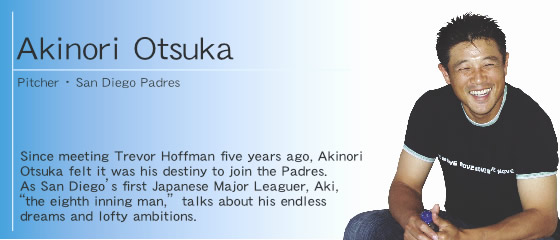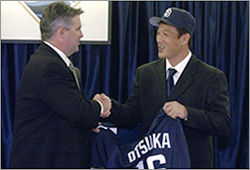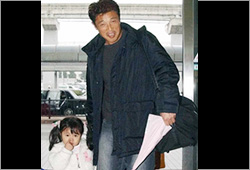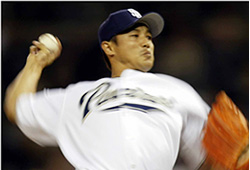YuYu interview Akinori Otsuka
 |
| —— You’ve had some outstanding performances as the Padres setup man, "the eighth inning man." Can you tell us how you feel about your first year in the Big Leagues? Before coming to the US, I had confidence in myself, like, "I can definitely do it." This is the way it should be. Otherwise, I wouldn't have decided to join the Major Leagues. But, to be honest with you, I didn't expect that things would go like this. (Laughter) I started to realize that I could do well in the Major Leagues during spring training, because what took place there helped to improve my control tremendously. 
A proud moment: Akinori Otsuka joins the Padres, holding his Number 16 uniform, and shaking hands with Kevin Towers, Padres
GM, December 11, 2003. (Kyodo) The Padres' primary catchers are Ramon Hernandez and Miguel Ojeda. At over 185cm, both of them are bigger and taller than typical Japanese catchers, so you'd think it'd be easier to throw the ball to them because the target is bigger. However, early on it was just the opposite. Japanese players are smaller, so Japanese catchers can set up low, holding their mitts close to their faces.Major League catchers tend to be much larger, so they can't lower their bodies and set up as low. They just lower their mitts, which creates an unwanted space between the mitt and the catcher's face. A pitcher sees the whole body of the catcher, so he can't help being aware of the space between the mitt and the catcher's face. In my case, this always causes me to throw high. I can't pinpoint the target. So, when I had just joined the Padres, I couldn't control my pitches at all. I couldn't think of any solutions, so I asked the catchers: "Move your face closer to the mitt. You can set up wide, but please lower your face a bit." At first, nobody took me seriously and they'd jokingly lay on their backs and set up, etc.... (Laughter) I had no choice, but to ask the coaches to tell the catchers to listen to me. After that, I was able to focus on the mitt and throw a lot of strikes which convinced the coaches and the catchers: "This is what you needed!" —— Although you were the losing pitcher in your debut game on April 6 against the Los Angeles Dodgers on their home ground, you haven’t allowed a run in 13 consecutive games, which is outstanding. I get an impression that you’ve learned something from your debut loss…. That's right. Although I was the losing pitcher, I felt like I got an answer to my question of how I should pitch to save a game. In that game, the pitch I threw that resulted in the game-winning hit was a forkball that I threw according to the sign. My control lacked precision. It was partly because of a lack of communication between the catcher and me. Still, that experience made me realize that my strengths are straight balls and sliders and that I should decide what type of pitch to throw when delivering a payoff pitch. My sliders break in several different ways, so I have an advantage in arranging a sequence of pitches. The best way for me is to throw strikes in a row and pressure the batter, then cap my pitches with a slider. The strike zone used in the Major Leagues is one ball wider on each side than Japan's. When I have confidence in my control, batters can't handle my pitches. If I throw pitches aimed precisely at the corners, it's easy to get strikes. During the off-season, I started practicing that and got used to it. From the game after my debut, I have changed. —— The media has been reporting that the National League Rookie of the Year may go to either New York Mets SS Kazuo Matsui, San Diego Padres SS Khalil Greene, or to you. Do you focus on receiving the Rookie of the Year title? Yes, of course. In Japan I didn't win any rookie awards, so I want to win one in the Major Leagues and am trying to get it. But, thatユs not my goal. My ultimate goal is to help my team win and help us get to the World Series, becoming number one in the world. —— You were named as a best pitcher while playing on the varsity team and became the 1998 Pacific League save leader as a pro in Japan. Can you tell us what made you pursue your career in the Major Leagues and when did you start thinking about it? Pitcher Hideo Nomo had a strong influence on me. I've been a fan of Mr. Nomo's. For my Padres uniform I requested number 16, because that was Nomo's number when he joined the Los Angeles Dodgers. When I joined the Kintetsu Buffaloes, I also took over Number 11, which was also Nomo's number during his Buffalo years. I started thinking about the Major Leagues sometime in my second year as a pro in Japan. It was while I was pitching to Major League batters during the Japan-U.S. All-Star Series in 1998, the same year which I became the Pacific League save leader. Seeing the power of Major Leaguers, I developed the ambition to play the game with them that got stronger and stronger every year. During the Japan-U.S. All-Star Series, I met the Padres' guardian god, closer Trevor Hoffman. Prior to the games, Trevor came to the ballpark earlier than anybody else and quietly engaged himself in training. He started with running and dashes, then did sit-ups, back strengthening exercises, and so on. His seriousness took my breath away and made me speechless. His attitude toward training was more outstanding and impressive than anybody else's. Among many leading closing relievers who participated in the Japan-U.S. All-Star Series, he was the No. 1 Major League closer. I was overwhelmed by his power. A closer who pitches the ninth inning and a setup man who comes into the game in the eighth inning have different states of mind. The mental pressure on the closer is incomparable. Being a closer requires a great deal of concentration, especially to close a game when your team is leading by only one run.... I thought I was used to those situations because I had been a closer in Japan. Still, when I saved a game for the first time in the Major Leagues against the Mets on April 30th, I was reacquainted with that pressure, and that made me admire Trevor even more. —— When Hoffman comes into a game in the ninth inning, AC/DC’s "Hell’s Bells" is blaring across the ballpark. Don’t you have a theme song? (Laughter) I do have one. (Laughter) When I come into a game, they play music for me too, but they put on a show only when Trevor comes out. This is like a honor for a closer. Normally, my position wouldn't allow me to have a theme song, but I requested one. (Laughter) When I was allowed to have one, so we decided on Metallica's "Wherever I May Roam." Trevor chose it for me, because it has a message, like, "I do wherever I go, Japan or America." —— You joined the Major Leagues through the posting system, without waiting to become eligible as a free agent. I’ve heard that no team bid for you in 2002 when you first tried to join the Major Leagues. What did you learn from that experience? If I had waited to become a free agent, I would have been more than 35 years old. So, I thought the posting system was the only way I could come to the Major Leagues. It was the most painful experience in my entire life that no team bid for me in that first year. But, I didn't waste that experience. The next year, I joined the Chunichi Dragons, from which I reaped a lot of benefits. I had teammates that I could trust, and on top of everything else, I gained valuable experience playing in the Central League. The Central League has an extremely exciting atmosphere, which is a bit different from the Pacific League. Playing against the Yomiuri Giants or the Hanshin Tigers, you can't play with a normal state of mind. People shout a lot of insults and cheering groups bring "music bands," and you can feel the vibrations even on the on the pitching on the mound. So the booing from the crowd in the Major Leagues is nothing for me, compared to what I experienced in the Central League. Compared to Japan, ballparks here are quiet, which lets me to concentrate on pitching. So, I think I'll be okay when we travel to Yankee Stadium. First of all, I don't understand the language, so no matter what the audience says to me. (Laughter) —— What is your impression of the Padres? Hoffman let you know about the team during the Japan-U.S. All-Star Series, so you must be feeling close to it. My teammates are all upbeat, and they talk to me and show their interest in Japan. I enjoy being part of the team. The other day, we went to Tijuana for Antonio Osuna's birthday. We had a good time there, having something to eat, playing cards, learning Latin dances to the beat of Mexican music, etc. In the bullpen, I try to mimic Antonio's dance. I am getting better. (Laughter) The players whom I turn to about English or American culture are pitchers Scott Linebrink and Trevor. Brian Giles and Phil Nevin often talk to me, too. Well, I'll exchange words with anybody with my limited English. At Petco Park, fans cheer the team on with good manners. In Japan, fans bring many things to the ballpark, but here people tend to enjoy baseball with their children, and that creates a homey atmosphere. 
San Diego Padres pitcher Akinori Otsuka heading to Australia from Osaka Airport for physical enhancement, February 5, 2004. (Kyodo)
challenge do you feel you need to overcome? That's to improve my English. I understand most of what the manager and the coaches are saying. I also understand the catchers, because they talk to me with gestures, like, "Take a deep breath." (Laughter) But, it is frustrating to be unable to fully express what I want to say. I should study English. During the game, I don't let the interpreter on the bench. I think it's better, because I don't want my teammates to belittle me, like, "That guy doesn't speak English." (Laughter) Although I've been getting help from the interpreter during this first year, next year I want to be able to handle the interviews by myself. —— What is the biggest difference between Major League baseball and Japanese professional baseball? Major League mounds are secured with clay, which works well with spikes and makes pitching easier. Throughout the pitching movement, such mounds make the pivot foot and the stepping foot stable. This is another reason why my control has become better. Japanese ballpark mounds are made with dry sandy soil that is unstable and slippery, which makes it difficult for a pitcher to control pitches. Also, training facilities in the Major Leagues are far better than those in Japan. They include family rooms for players' families, and even babysitters are available. Following the guidance of their training coaches, players can train and build their bodies according to their daily workout structure. Also, unlike Japan, the players have the freedom to take their families on road trips. If you pay out of your pocket for flight tickets or hotel rooms for your family, the team staff will take care of booking the flights, hotels, etc. As for airplanes, I've been reminded of how impressive the Major Leagues are. The Padres' charter plane has all first-class seats, and the meals and snacks on board are wonderful. You can drink beer or play games, so you can really travel comfortably. —— Many of the top Japanese players have joined the Major Leagues. Do you feel the "hollowing-out" of Japanese professional baseball has started? I've often heard this mentioned, but I don't think it's possible for Japanese professional baseball to become "hollowed-out" or to decline. Even though top players like Mr. Nomo or Hideki Matsui are joining the Major Leagues, more and more young and capable players coming up and replacing them on the Japanese teams, so I don't think it's something to worry about it. I don't think the fans of Japanese baseball are going to stop going to Japanese ballparks just because people are watching the Major League games on TV. When I played in Japan, I sensed the fans' enthusiasm, which made me realize that they still enjoyed the game. 
Otsuka taking on the Montreal Expos at Petco Park and taking home his second win, April 27, 2004. (Kyodo)
My dream has changed after coming to San Diego. (Laughter) I wake up in the morning and enjoy the panoramic view from Mission Bay to the Pacific Oceanムfrom my place. This is my happiest moment. The best living environment it's not too much to say that this is the reason that I am in good condition. I would like to continue living in San Diego and playing for the Padres as long as I can. That's how I feel. I hope I can keep playing until I'm 40. After my retirement, I still want to live here and start a new career. I may want to take a position that lets me scout capable players from Japan, or become a coach. These are my dreams. If I decide to go back to Japan, I want to use my experience in the Major Leagues and help Japanese professional baseball improve. As a starting point, I would like to improve all the unstable mounds in the Japanese ballparks. I feel sorry for the pitchers there who have to use such mounds. —— You are the first Japanese player on the Padres, so the fans in San Diego pay attention and look forward to your continued good performances. Do you have any message for the local fans? I wish I could say, "I'll lead the team to victory," but I can't make it happen alone.... (Laughter) Let's see...Petco Park opened in Downtown this year, and I am happy to be a member of the team that plays at the new ballpark. The team is doing well and trying to win the division. I believe that if I work hard as a setup man, we'll have good results. Please come to Petco Park and listen to my victory cry! You'll see "I did it! (Yossha!)" on the screen. (Laughter) —— When you strike out a batter, you yell "Yossha!" while doing your victory pose, right? That's a habit. In the Kansai region of Japan, people often say it, and I brought it to the Major Leagues. Actually, former Buffalo's manager Mr. Kyosuke Sasaki was called "Yossha Sasaki," and it somehow became a trademark of the Buffaloes, and their players often yelled "Yossha." Another dream of mine is for "Yossha" to become popular expression among Major League pitchers and for them to know where it comes from a lively Japanese setup man who pitched for the Padres' as they pass it on to future generations. (Laughter) (05-16-2004 issue) |

